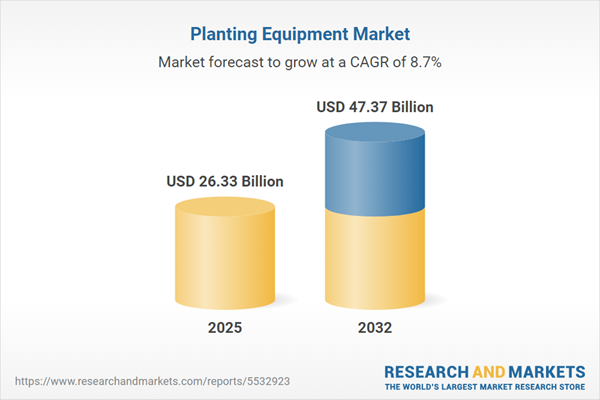Speak directly to the analyst to clarify any post sales queries you may have.
The planting equipment market is experiencing rapid transformation, driven by technological innovation and changing agribusiness priorities. Senior decision-makers are leveraging advanced machinery and integrated digital solutions to align operations with evolving production goals and maintain long-term competitiveness.
Market Snapshot: Planting Equipment Market Trends
Steady expansion in the planting equipment market is closely linked to the rising focus on food security, productivity, and sustainable practices. Organizations are adopting precision technologies that enable detailed monitoring and targeted field operations. With increased emphasis on transparency and adaptability, agriculture leaders are integrating digital platforms and equipment enhancements to support dynamic sector demands. This market shift accommodates diverse farm sizes and ensures resilience, even as regulations, economic factors, and environmental conditions continue to change.
Scope & Segmentation in the Planting Equipment Market
- Product Types: Air planters, finger pickup planters, broadcast seeders, grain drills, and precision planting systems allow companies to address a range of agronomic and operational needs effectively.
- Seeding Mechanisms: Mechanical, pneumatic, and vacuum-powered solutions—offering central or row-unit metering—support varying requirements for seeding accuracy and accessibility across organizations of all sizes.
- Operation Types: Solutions are available for conventional, minimum-till, or no-till strategies, permitting farms to prioritize sustainability or soil health as needed.
- Farm Sizes: Planting equipment options address both small- and large-scale farms, supporting scalable growth and boosting operational productivity regardless of organization size.
- Row Widths: Narrow, standard, and wide configurations optimize planting density for diverse crops and help farms achieve targeted outcomes across different environments.
- Power Sources: Electric, self-propelled, and tractor-driven variants integrate seamlessly with existing fleets, promoting phased equipment investment as operations expand or modernize.
- Applications: Equipment designed for cereals, oilseeds, and vegetables broadens production flexibility and meets the increasingly varied demands of modern crop management.
- Sales Channels: Accessible dealer networks and digital procurement platforms guide purchasing decisions and enable reliable after-sales support for agricultural organizations globally.
- Key Regions: The Americas, Europe, Middle East & Africa, and Asia-Pacific each bring unique market pressures, compliance expectations, and expansion opportunities shaping equipment adoption and investment strategies.
- Leading Companies: Major firms including Deere & Company, CNH Industrial N.V., AGCO Corporation, Kubota Corporation, Mahindra & Mahindra Limited, CLAAS KGaA mbH, Yanmar Co., Ltd., Väderstad Holding AB, Valmont Industries, Inc., and Precision Planting LLC support continuous technological advancement and efficient cross-border supply chains.
Adaptability to varying farm infrastructures and compliance requirements, paired with robust partnerships across the supply chain, is a critical component of commercial success in this evolving landscape.
Key Takeaways for Senior Decision-Makers
- Digital planting equipment gives agricultural executives enhanced real-time insight, supporting better oversight and stronger data-driven decision-making throughout each planting cycle.
- Modular and customizable machinery streamlines adaptation to changing field or market conditions with minimal operational disruption, strengthening organizational flexibility and speed.
- Integrating machine learning with conventional farming methods elevates resource utilization and extends the working life of core planting infrastructure assets.
- Advanced diagnostics and maintenance scheduling help protect equipment performance and maintain streamlined agricultural workflows while supporting ongoing supplier engagement.
- Flexible procurement models, such as bundled support and scalable service packages, provide reliable coverage for evolving compliance and help maintain equipment uptime.
- Comprehensive financing options and tailored service agreements enable senior leaders to optimize asset planning and effectively manage equipment across its full lifecycle.
Tariff Impact: Preparing for United States 2025 Tariff Changes
Forthcoming changes to United States tariffs require a proactive approach to procurement and supply chain management. Senior leaders should focus on robust supplier relationships and regional sourcing strategies to minimize emerging risks. Leveraging agile procurement methods and responsive logistics will support continued market performance and regulatory alignment through periods of policy transition.
Methodology & Data Sources
This report uses direct interviews with industry participants, comprehensive sector-wide surveys, trade flow analysis, and regulatory review. Combining these methods ensures thorough insight into planting equipment trends and executive priorities, underpinning a detailed perspective for senior decision-makers.
Why This Planting Equipment Market Report Matters
- Enables leaders to strategically align organizational goals and investment strategies with the latest advancements and shifts within the planting equipment market.
- Supports benchmarking of operations and priorities against global regional standards, with actionable guidance for strength in established and emerging markets.
- Offers practical insights that equip senior executives to build long-term value and enhance their competitive market positioning.
Conclusion
Staying ahead of technology and policy changes ensures reliable, resilient investment decisions in planting equipment. Informed leadership will help drive measurable value and secure a competitive advantage for agricultural enterprises.
Additional Product Information:
- Purchase of this report includes 1 year online access with quarterly updates.
- This report can be updated on request. Please contact our Customer Experience team using the Ask a Question widget on our website.
Table of Contents
3. Executive Summary
4. Market Overview
7. Cumulative Impact of Artificial Intelligence 2025
Companies Mentioned
The companies profiled in this Planting Equipment market report include:- Deere & Company
- CNH Industrial N.V.
- AGCO Corporation
- Kubota Corporation
- Mahindra & Mahindra Limited
- CLAAS KGaA mbH
- Yanmar Co., Ltd.
- Väderstad Holding AB
- Valmont Industries, Inc.
- Precision Planting LLC
Table Information
| Report Attribute | Details |
|---|---|
| No. of Pages | 196 |
| Published | November 2025 |
| Forecast Period | 2025 - 2032 |
| Estimated Market Value ( USD | $ 26.33 Billion |
| Forecasted Market Value ( USD | $ 47.37 Billion |
| Compound Annual Growth Rate | 8.7% |
| Regions Covered | Global |
| No. of Companies Mentioned | 11 |









